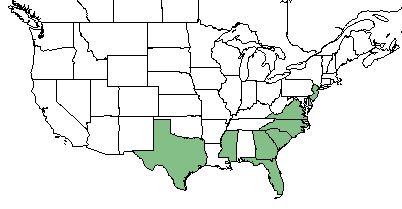Difference between revisions of "Cirsium virginianum"
(→Description) |
|||
| Line 34: | Line 34: | ||
| − | ''C. virginianum'' can be found in moist to fairly dry pine savannas and bogs.<ref name="Weakley">Weakley, A. S. (2015). Flora of the Southern and Mid-Atlantic States. Chapel Hill, NC, University of North Carolina Herbarium. </ref> The species has been observed in to grow in disturbed areas.<ref name="Herbarium">Florida State University Robert K. Godfrey Herbarium database. URL: http://herbarium.bio.fsu.edu. Last accessed: May 2018. Collectors: Robert K. Godfrey, R. Komarek, B. A. Sorrie, L. G. Chafin, L. G. Chafin, and C. Pederson. States and Counties: Georgia: Thomas and Worth. Florida: Clay and Escambia. </ref> As well, it is listed as a facultative wetland species, where it usually grows in wetlands but can occasionally can be found in non-wetlands.<ref name= "USDA"/> | + | ''C. virginianum'' can be found in moist to fairly dry pine savannas and bogs.<ref name="Weakley">Weakley, A. S. (2015). Flora of the Southern and Mid-Atlantic States. Chapel Hill, NC, University of North Carolina Herbarium. </ref> This includes pine wiregrass or saw palmetto flatwoods, ecotones between upland and streamheads, and ecotones between uplands and pocosins.<ref name= "nature"/> The species has been observed in to grow in disturbed areas.<ref name="Herbarium">Florida State University Robert K. Godfrey Herbarium database. URL: http://herbarium.bio.fsu.edu. Last accessed: May 2018. Collectors: Robert K. Godfrey, R. Komarek, B. A. Sorrie, L. G. Chafin, L. G. Chafin, and C. Pederson. States and Counties: Georgia: Thomas and Worth. Florida: Clay and Escambia. </ref> As well, it is listed as a facultative wetland species, where it usually grows in wetlands but can occasionally can be found in non-wetlands.<ref name= "USDA"/> |
Associated Species - ''Hyptis alata'', ''Myrica cerifera'' var. ''cerifera'', ''Iva microcephala'', ''Tridens ambiguus'', ''Serenoa repens'', ''Rudbeckia nitida'', ''Galium aparine'', ''Vicia angustifolia'', ''Geranium carolinianum'', and ''Trifolium campestre''. <ref name="Herbarium"/> | Associated Species - ''Hyptis alata'', ''Myrica cerifera'' var. ''cerifera'', ''Iva microcephala'', ''Tridens ambiguus'', ''Serenoa repens'', ''Rudbeckia nitida'', ''Galium aparine'', ''Vicia angustifolia'', ''Geranium carolinianum'', and ''Trifolium campestre''. <ref name="Herbarium"/> | ||
Revision as of 08:34, 8 April 2019
Common names: Virginia Thistle
| Cirsium virginianum | |
|---|---|

| |
| Photo by the Southeastern Flora Plant Database | |
| Scientific classification | |
| Kingdom: | Plantae |
| Division: | Magnoliophyta - Flowering plants |
| Class: | Magnoliopsida - Dicots |
| Order: | Asterales |
| Family: | Asteraceae |
| Genus: | Cirsium |
| Species: | C. virginianum |
| Binomial name | |
| Cirsium virginianum L | |

| |
| Natural range of Cirsium virginianum from USDA NRCS Plants Database. | |
Contents
Taxonomic Notes
Synonyms: Carduus virginianus Linnaeus, Cirsium revolutum (Small) Petrak
Varieties: none
Description
C. virginianum is a biennial forb in the Asteraceae family native to the southeast United States.[1] It can reach heights up to 6 feet tall.[2] Stem has white cobweb-like hairs, and leaves are spiny-edged, dissected or uncut, and underside white with short dense hairs. Flowers occur in dense heads, and purple/pink in color.[3]
Distribution
C. virginianum can be found along the southeast United States, ranging from Texas to New Jersey. However, it is mostly found in the Carolinas [1].
Ecology
Habitat
C. virginianum can be found in moist to fairly dry pine savannas and bogs.[4] This includes pine wiregrass or saw palmetto flatwoods, ecotones between upland and streamheads, and ecotones between uplands and pocosins.[3] The species has been observed in to grow in disturbed areas.[5] As well, it is listed as a facultative wetland species, where it usually grows in wetlands but can occasionally can be found in non-wetlands.[1]
Associated Species - Hyptis alata, Myrica cerifera var. cerifera, Iva microcephala, Tridens ambiguus, Serenoa repens, Rudbeckia nitida, Galium aparine, Vicia angustifolia, Geranium carolinianum, and Trifolium campestre. [5]
Phenology
C. virginianum typically flowers from August to October [4], but has been observed to flower as early as April [5].
Fire ecology
The species has been observed in to grow in areas that are burned annually [5].
Conservation and Management
This species is listed as endangered by the New Jersey Department of Environmental Protection and Energy. It is also considered a noxious weed by the Arkansas State Plant Board and the Iowa Department of Agriculture and Land Stewardship.[1]
Cultivation and restoration
Photo Gallery
References and notes
- ↑ 1.0 1.1 1.2 1.3 USDA Plants Database URL: https://plants.usda.gov/core/profile?symbol=CIVI
- ↑ [[1]] Lady Bird Johnson Wildflower Center. Accessed: April 8, 2019
- ↑ 3.0 3.1 [[2]] NatureServe Explorer. Accessed: April 8, 2019
- ↑ 4.0 4.1 Weakley, A. S. (2015). Flora of the Southern and Mid-Atlantic States. Chapel Hill, NC, University of North Carolina Herbarium.
- ↑ 5.0 5.1 5.2 5.3 Florida State University Robert K. Godfrey Herbarium database. URL: http://herbarium.bio.fsu.edu. Last accessed: May 2018. Collectors: Robert K. Godfrey, R. Komarek, B. A. Sorrie, L. G. Chafin, L. G. Chafin, and C. Pederson. States and Counties: Georgia: Thomas and Worth. Florida: Clay and Escambia.